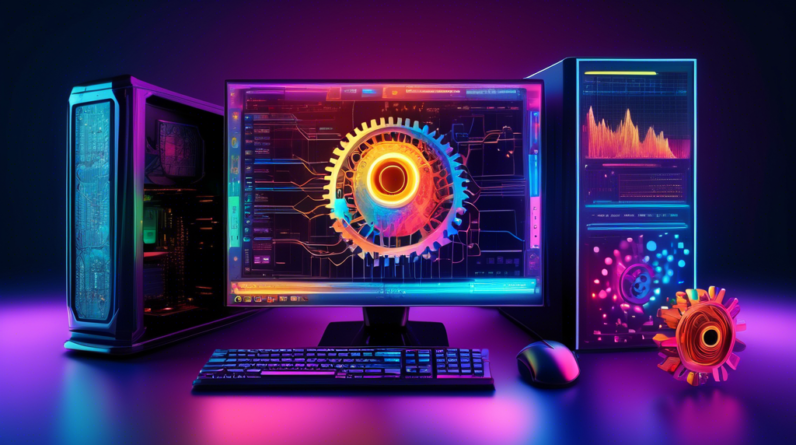
Artificial intelligence (AI) is rapidly changing the world as we know it. From self-driving cars to facial recognition software, AI is already having a major impact on our lives. And as AI continues to develop, it’s only going to become more powerful and more ubiquitous.
Why Build Your Own AI Modelling Machine?
Building your own AI modelling machine can seem like a daunting task, but it’s becoming increasingly accessible thanks to companies like Gigabyte. There are several compelling reasons to consider embarking on this journey:
- Customization: Tailor the hardware components precisely to your AI workload, whether it’s natural language processing, computer vision, or deep learning. You’re not limited by pre-configured options.
- Cost Control: Building your own machine can potentially save you money compared to purchasing a pre-built workstation, especially for high-performance systems.
- Scalability: Start with a solid foundation and easily upgrade or expand your system as your AI projects grow in complexity and data size.
- Learning Experience: The process of researching, selecting, and assembling an AI machine provides invaluable hands-on experience with hardware and software integration.
Gigabyte: Empowering AI Development
Gigabyte, a leading name in computer hardware, understands the needs of AI developers and researchers. The company offers a range of components specifically designed to accelerate AI workloads, making it easier than ever to build a powerful and efficient AI modelling machine.
Key Components for Your AI Build
Building an effective AI modelling machine requires careful consideration of several key components:
1. Motherboard: The Foundation
The motherboard serves as the backbone of your system. Gigabyte’s AI-optimized motherboards, such as those in their Z690 AORUS series, are designed for high-performance computing. Look for features like:
- Support for multiple high-end CPUs with numerous cores and threads.
- Ample RAM slots with support for fast and high-capacity DDR5 memory.
- Multiple PCIe 4.0 slots for ultra-fast GPU connectivity.
2. CPU: The Brain
The CPU is the brain of your AI system. Intel’s latest generation Core i9 processors, like the 13900K, offer exceptional multi-core performance, making them ideal for handling complex AI algorithms. Consider these factors:
- Core Count and Threads: More cores and threads translate to better parallel processing, crucial for AI workloads.
- Clock Speed: Higher clock speeds can speed up certain AI tasks, but focus on core count for deep learning.
- Cache Memory: A larger CPU cache can help reduce data access times, improving efficiency.
3. GPU: The AI Accelerator
GPUs are the workhorses of AI, especially deep learning. NVIDIA’s GeForce RTX 30 series and their professional-grade A series GPUs (e.g., A100, A40) are specifically designed for AI workloads. Consider these factors:
- CUDA Cores and Tensor Cores: Specialized cores designed for accelerating AI computations.
- VRAM: Sufficient video RAM is essential, especially for large datasets. Opt for GPUs with 24GB or more.
- Compute Performance: Measured in TFLOPS, higher numbers indicate faster processing for AI tasks.
4. RAM: The Memory Powerhouse
AI workloads demand a lot of RAM to store massive datasets and intermediate calculations. Aim for at least 32GB of high-speed DDR5 RAM, and consider 64GB or more for demanding tasks. Gigabyte motherboards are optimized to take advantage of the latest RAM speeds.
5. Storage: Fast and Ample
Fast storage is crucial for loading and processing data efficiently. Consider these options:
- NVMe SSDs: Provide lightning-fast read and write speeds, ideal for your operating system and frequently accessed data.
- High-Capacity HDDs: Offer a cost-effective solution for storing large datasets. Consider a RAID configuration for redundancy and speed.
6. Power Supply: Stable and Reliable
A high-wattage power supply is essential to provide stable power to your power-hungry components, especially multiple GPUs. Consider 80 Plus Gold or Platinum certified PSUs from reputable brands.
7. Cooling: Keep It Cool
AI workloads generate a lot of heat. Adequate cooling is crucial to prevent thermal throttling and maintain system stability. Consider:
- High-performance CPU coolers: Air or liquid cooling solutions to keep your CPU within optimal temperature ranges.
- Case fans: Ensure good airflow within the case to dissipate heat efficiently.
- GPU cooling solutions: Some high-end GPUs may benefit from aftermarket cooling solutions for improved performance.
Putting It All Together: Building Your Machine
Once you have carefully selected your components, the actual building process involves assembling them within your chosen PC case. There are numerous online resources and tutorials available to guide you through each step. Remember to:
- Follow anti-static precautions to protect sensitive components.
- Consult your motherboard manual for specific installation instructions.
- Take your time and ensure all connections are secure.
Software and Optimization
With your AI machine built, the next step is installing the necessary software:
- Operating System: Choose a suitable OS like Windows 10/11 or a Linux distribution popular among developers (e.g., Ubuntu, Fedora).
- Drivers: Install the latest drivers for your motherboard, GPU, and other peripherals.
- Deep Learning Frameworks: Install frameworks like TensorFlow, PyTorch, or Keras, depending on your chosen AI tasks.
- CUDA and cuDNN: Install NVIDIA’s CUDA toolkit and cuDNN library to enable GPU acceleration for your AI workloads.
Conclusion: Empowering the Future of AI
Building your own AI modelling machine is no longer an insurmountable task. With Gigabyte’s range of AI-optimized components and the guidance provided in this article, you’re well-equipped to embark on this exciting journey. By carefully selecting your components and assembling your system, you can create a powerful and efficient machine tailored to your specific AI workloads. As AI continues to reshape our world, building your own AI system allows you to be at the forefront of this technological revolution, experimenting with cutting-edge algorithms and pushing the boundaries of what’s possible.




